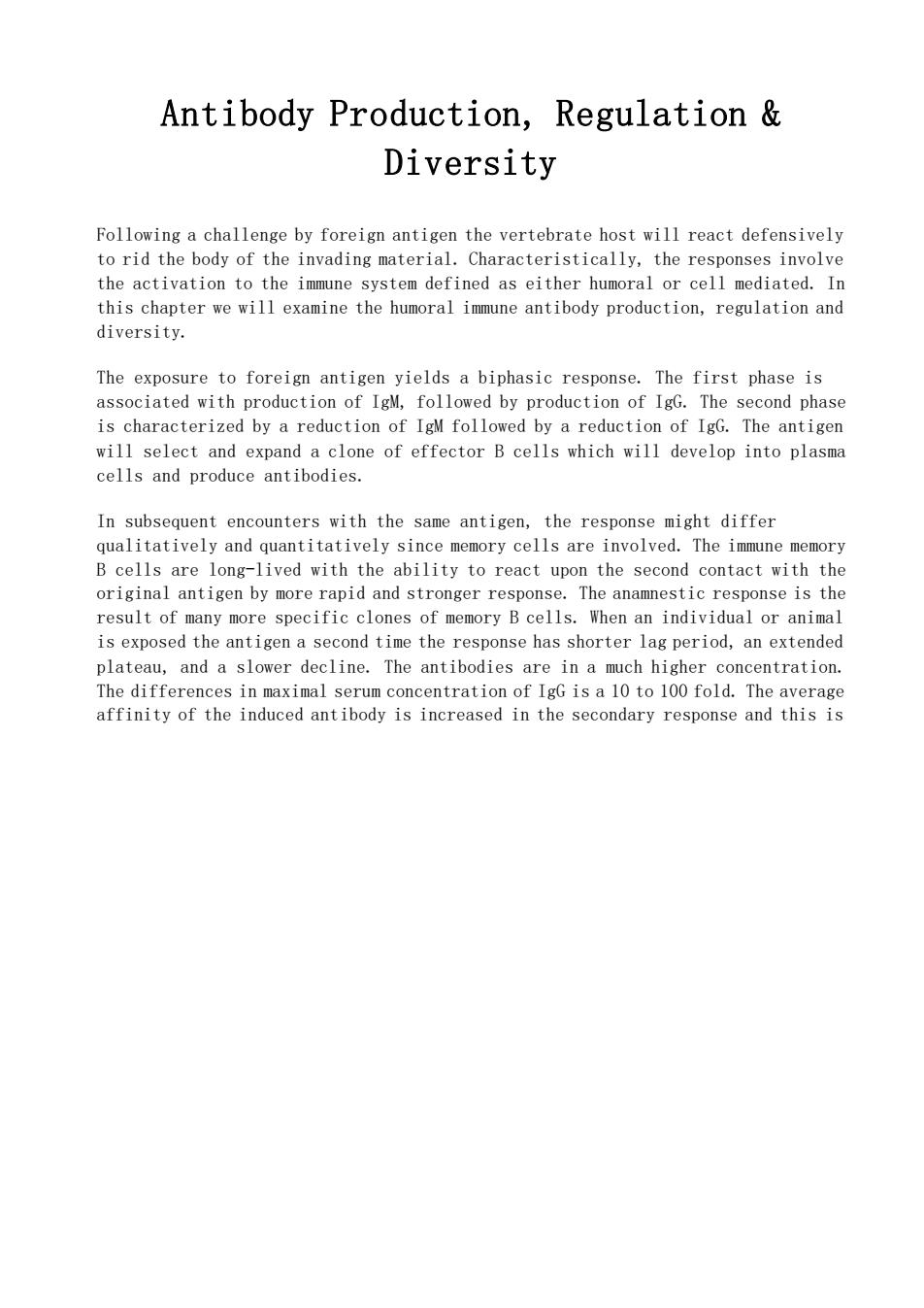
Antibody Production,Regulation Diversity Following a challenge by foreign antigen the vertebrate host will react defensively In this chapter we will examine the humoral immune antibody production,regulation and diversity. The exposure to foreign antigen yields a biphasic response.The first phase is associated with production of IgM,followed by production of IgG.The second phase is characterized by a reduction by a reduction ofIg.The antigen will select and expand a clone of effector B cells which will develop into plasma cells and produce antibodies. In subsequent encounters with the same antigen,the response might differ qualitatively and quantitatively since memory cells are involved.The immune memory Bcells are long-lived with the ability to react upon the second contact with the original antigen byore rapid and stronger respons e anamnes + nse is the result of many more specific clones of memory B cells.When an individual or animal is exposed the antigen a second time the response has shorter lag period,an extended plateau,and a slower decline.The antibodies are in a much higher concentration
Antibody Production, Regulation & Diversity Following a challenge by foreign antigen the vertebrate host will react defensively to rid the body of the invading material. Characteristically, the responses involve the activation to the immune system defined as either humoral or cell mediated. In this chapter we will examine the humoral immune antibody production, regulation and diversity. The exposure to foreign antigen yields a biphasic response. The first phase is associated with production of IgM, followed by production of IgG. The second phase is characterized by a reduction of IgM followed by a reduction of IgG. The antigen will select and expand a clone of effector B cells which will develop into plasma cells and produce antibodies. In subsequent encounters with the same antigen, the response might differ qualitatively and quantitatively since memory cells are involved. The immune memory B cells are long-lived with the ability to react upon the second contact with the original antigen by more rapid and stronger response. The anamnestic response is the result of many more specific clones of memory B cells. When an individual or animal is exposed the antigen a second time the response has shorter lag period, an extended plateau, and a slower decline. The antibodies are in a much higher concentration. The differences in maximal serum concentration of IgG is a 10 to 100 fold. The average affinity of the induced antibody is increased in the secondary response and this is
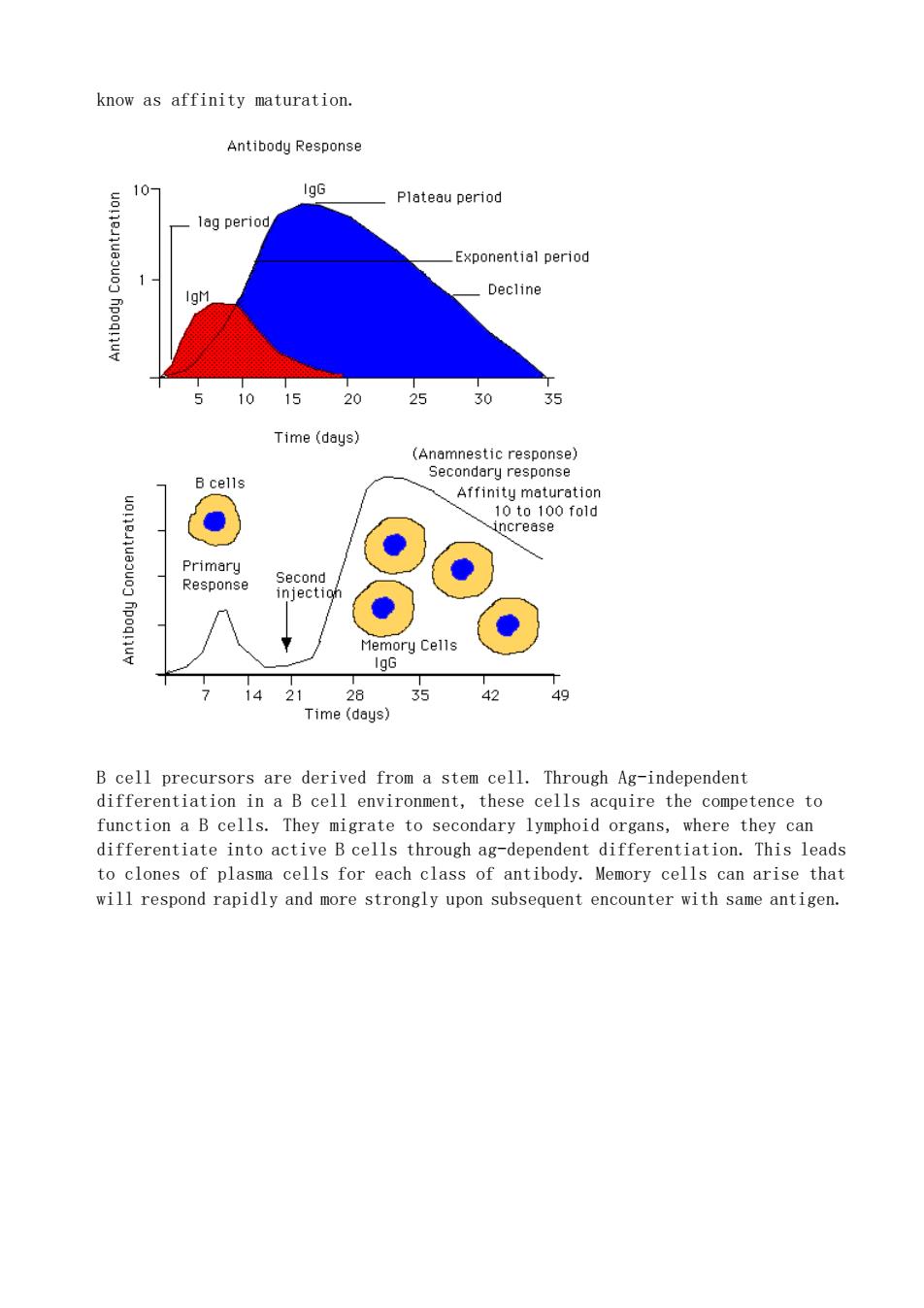
know as affinity maturation. Antibody Response 10 Plateau period lag perioc Exponential period 1 Decline 1015 20 30 35 Time(days) (Anamnestic response) 3 cells Primary 14 21 28 35 42 49 ime(deys) B cell precursors are derived from a stem cell.Through Ag-independent differentiation in a B cell environment,these cells acquire the competence to function a B cells.They migrate to secondary lymphoid organs,where they can differentiate into active B cells through ag-dep ndent differentiation.This leads to clones of plasma cells for each class of antibody.Memory cells can arise that will respond rapidly and more strongly upon subsequent encounter with same antigen
know as affinity maturation. B cell precursors are derived from a stem cell. Through Ag-independent differentiation in a B cell environment, these cells acquire the competence to function a B cells. They migrate to secondary lymphoid organs, where they can differentiate into active B cells through ag-dependent differentiation. This leads to clones of plasma cells for each class of antibody. Memory cells can arise that will respond rapidly and more strongly upon subsequent encounter with same antigen
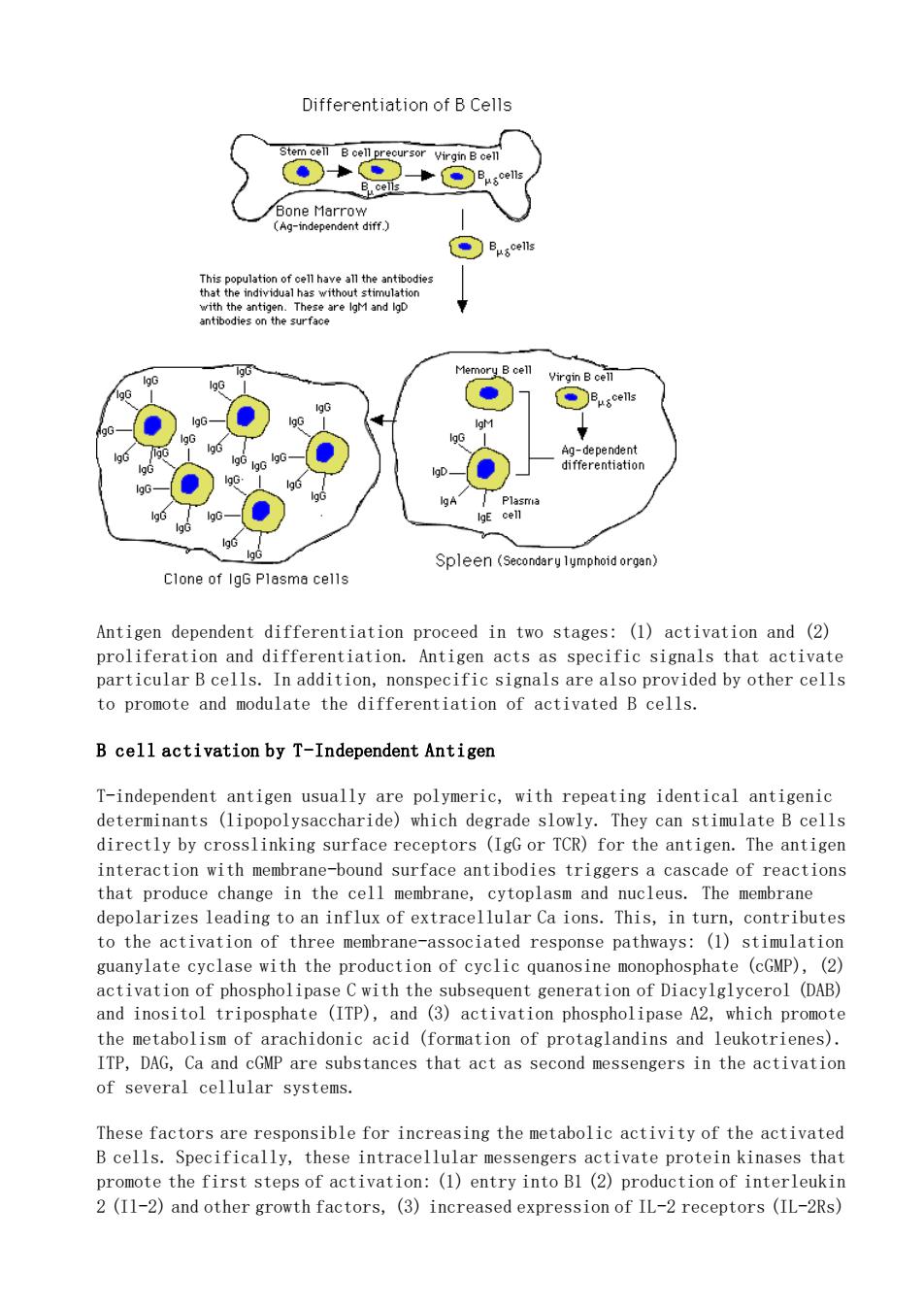
Differentiation of B Cells 6onerharaaid amp Virgin B cell Clone of lgG Plasma cells Antigen dependent differentiation proceed in two stages:(1)activation and (2) proliferation and differentiation.Antigen acts as specific signals that activate particular B cells.In addition,nonspecific signals are also provided by other cells and modulate the differentiation of activated B cells. B cell activation by T-Independent Antigen T-independent antigen usually are polymeric,with repeating identical antigenic determinants (lipopolysaccharide)which degrade slowly.They can stimulate B cells directly by crosslinking surface receptors(IgG or TCR)for the antigen.The antigen interaction with membran e-bo und surface antibodies triggers a cascade of reactions that produ ange in the cell membrane, cytoplasm and nucleus.The membran depolarizes leading to an influx of extracellular Ca ions.This,in turn,contributes to the activation of three membrane-associated response pathways:(1)stimulation guanylate cyclase with the production of cyclic quanosine monophosphate (cGMP),(2) activation of phospholipase c with the subsequent generation of diacyiglycerol (Dab) and inositol triposphate (ITP),and(3)activation phospholipase A2.which promote the metabolism of arachidonic acid(formation of protaglandins and leukotrienes) ITP,DAG,Ca and cGMP are substances that act as second messengers in the activation of several cellular systems. These factors are responsible for increasing the metabolic activity of the activated promote the first steps of activatic 2(I1-2)and other growth factors,(3)increased expression of IL-2 receptors (IL-2Rs)
Antigen dependent differentiation proceed in two stages: (1) activation and (2) proliferation and differentiation. Antigen acts as specific signals that activate particular B cells. In addition, nonspecific signals are also provided by other cells to promote and modulate the differentiation of activated B cells. B cell activation by T-Independent Antigen T-independent antigen usually are polymeric, with repeating identical antigenic determinants (lipopolysaccharide) which degrade slowly. They can stimulate B cells directly by crosslinking surface receptors (IgG or TCR) for the antigen. The antigen interaction with membrane-bound surface antibodies triggers a cascade of reactions that produce change in the cell membrane, cytoplasm and nucleus. The membrane depolarizes leading to an influx of extracellular Ca ions. This, in turn, contributes to the activation of three membrane-associated response pathways: (1) stimulation guanylate cyclase with the production of cyclic quanosine monophosphate (cGMP), (2) activation of phospholipase C with the subsequent generation of Diacylglycerol (DAB) and inositol triposphate (ITP), and (3) activation phospholipase A2, which promote the metabolism of arachidonic acid (formation of protaglandins and leukotrienes). ITP, DAG, Ca and cGMP are substances that act as second messengers in the activation of several cellular systems. These factors are responsible for increasing the metabolic activity of the activated B cells. Specifically, these intracellular messengers activate protein kinases that promote the first steps of activation: (1) entry into B1 (2) production of interleukin 2 (Il-2) and other growth factors, (3) increased expression of IL-2 receptors (IL-2Rs)
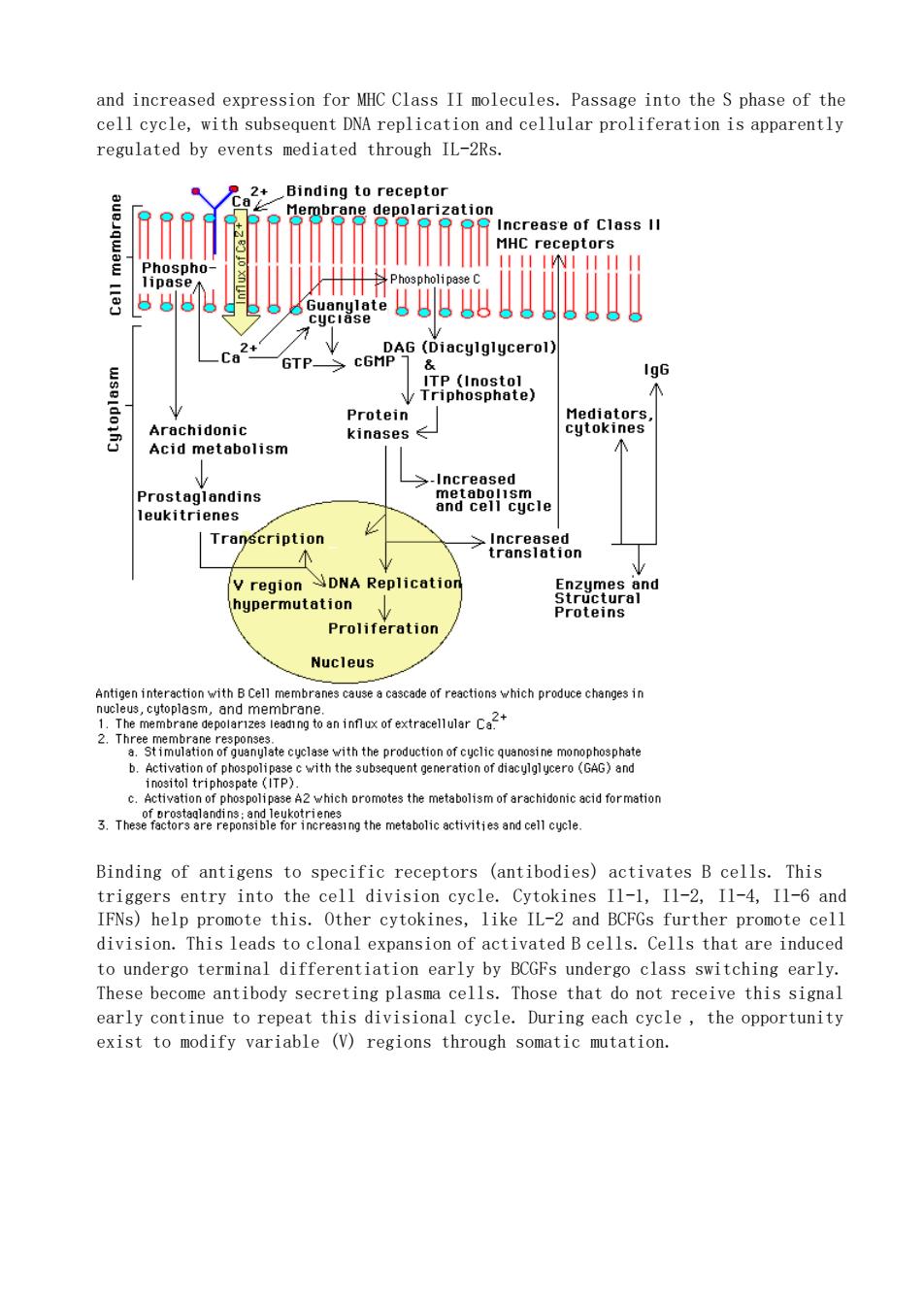
and increased expression for MHC Class II molecules.Passage into the S phase of the cell cycle,with subsequent DNA replication and cellular proliferation is apparently regulated by events mediated through IL-2Rs. 2+ Binding to receptor Increase of Class II 02 Protein kinases← -Increased din meecycle Transcription v region DNA Replication utation Nucleus TA ofxtraceurCa ee membra P) C. vation of A2 which promotes the metabolism of arachidonic acid formation Binding of antigens to specific receptors (antibodies) activates B cells.This triggers entry into the cell division cycle Cytokines I1-1,I1-2,I1-4,I1-6 and IFNs)help promote this.Other cytokines,like IL-2 and BCFGs further promote cell division.This leads to clonal expansion of activated B cells.Cells that are induced to undergo terminal differentiation early by BCGFs undergo class switching early. These be antibody ting asma cells.Those that do no eceive this signa early continue to repeat this divisional cycle.During each cycle,the opportunity exist to modify variable (V)regions through somatic mutation
and increased expression for MHC Class II molecules. Passage into the S phase of the cell cycle, with subsequent DNA replication and cellular proliferation is apparently regulated by events mediated through IL-2Rs. Binding of antigens to specific receptors (antibodies) activates B cells. This triggers entry into the cell division cycle. Cytokines Il-1, Il-2, Il-4, Il-6 and IFNs) help promote this. Other cytokines, like IL-2 and BCFGs further promote cell division. This leads to clonal expansion of activated B cells. Cells that are induced to undergo terminal differentiation early by BCGFs undergo class switching early. These become antibody secreting plasma cells. Those that do not receive this signal early continue to repeat this divisional cycle. During each cycle , the opportunity exist to modify variable (V) regions through somatic mutation
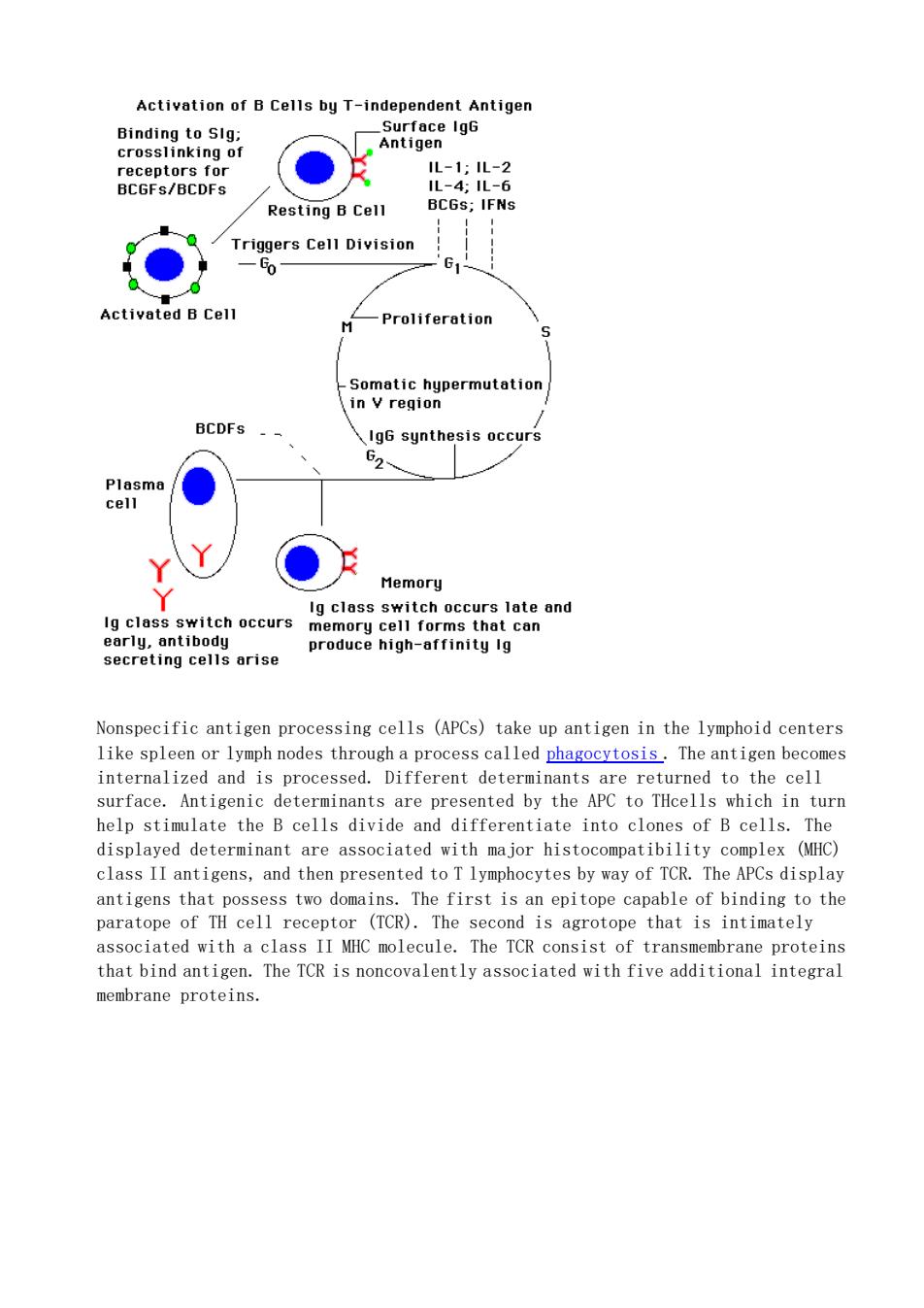
Activation of B Cells by T-independent Antigen Binding to Slg Antigen king of ● L-1:L-2 BCGFs/BCDFS Resting B Cell Triggers Cell Division Activated B Cell Proliferation BCDFs 1g6 sunthesis occurs 62… Memory g class switch occurs Ig class switch occu earamlitetg produce high-affinity lg rise Nonspecific antigen processing cells (APCs)take up antigen in the lymphoid centers like spleen or lymph nodes through a process called phagocytosis.The antigen becomes internalized and is processed.Different determinants are returned to the cell surface.Antigenic determinants are presented by the APC to THcells which in turn help stimulate the B cells divide and differentiate into clones of B cells.The displayed determinant are associated with major histocompatibility comple (MHC) class II antigens,and then presented to T lymphocytes by way of TCR.The APCs display antigens that possess two domains.The first is an epitope capable of binding to the paratope of TH cell receptor (TCR).The second is agrotope that is intimately associated with a class II MHC molecule.The TCR consist of transmembrane proteins that bind antigen.The TCR is noncovalently associated with five additional integral membrane proteins
Nonspecific antigen processing cells (APCs) take up antigen in the lymphoid centers like spleen or lymph nodes through a process called phagocytosis . The antigen becomes internalized and is processed. Different determinants are returned to the cell surface. Antigenic determinants are presented by the APC to THcells which in turn help stimulate the B cells divide and differentiate into clones of B cells. The displayed determinant are associated with major histocompatibility complex (MHC) class II antigens, and then presented to T lymphocytes by way of TCR. The APCs display antigens that possess two domains. The first is an epitope capable of binding to the paratope of TH cell receptor (TCR). The second is agrotope that is intimately associated with a class II MHC molecule. The TCR consist of transmembrane proteins that bind antigen. The TCR is noncovalently associated with five additional integral membrane proteins